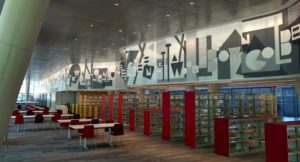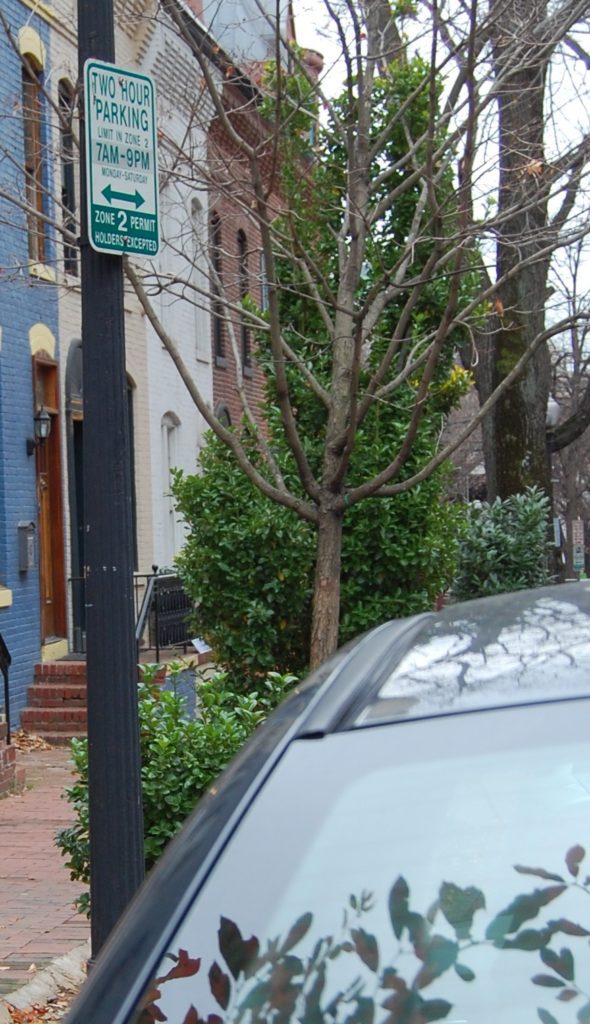Compromise Urged on Parking Proposal
Though it started off on an ominous note, the much-touted community discussion of a proposal to reserve one side of every street in Georgetown for resident parking was lively and civil at the Dec. 4 meeting of the Georgetown-Burleith Advisory Neighborhood Commission.
But attention quickly turned to Georgetown’s m ost s tubborn and perennial problem: what to do about parking as residents with children and SUVs increase in number, along with workers, shoppers and other visitors.
They talked about the need for everyone to understand all sides. Small business owners expressed concern that w ith the loss of one side of the street to resident parking — plus subtractions of metered street parking due to bike lanes, expanded sidewalks, construction sites a nd months’-long dumpster filling — would make some customers already teetering about the parking situation to give up on the destination altogether.
Georgetown to Glow Starting Dec. 8

“Aqueous” by Jen Lewin will be part of Georgetown “Glow.” Photo by Morgan Sasser. Courtesy Georgetown BID.
Georgetown will glow every evening from Friday, Dec. 8, through Sunday, Jan. 7, thanks to the outdoor festival of light art called “Georgetown Glow.” The fourth annual “Glow” will include a number of special events, including a silent disco on Dec. 9 at the Washington Harbour and an extended evening of shopping on Dec. 14.
Art works include “Horizontal Interference” at the Washington Harbour, a collection of colorful cords connecting trees and light poles by Polish artists Joachim Slugocki and Katarzyna Malejka. “Aqueous,” 62 illuminated platforms by Brooklyn-based artist Jen Lewin, is set up at Georgetown Waterfront Park near the intersection of Wisconsin Avenue and K Street.
Sponsored by the Georgetown Business Improvement District, “Glow” is also partly funded by a $150,000 grant from the D.C. Commission on the Arts and Humanities.
New West End Library Opens Dec. 9

Courtesy DCPL.
Forty thousand books, 40 desk-top computers and thousands of DVDs, CDs, audio books and publications have been moved into 21,000 square feet of sun-filled, spacious and airy library rooms in preparation for the grand opening of the brand-new West End Library at 2301 L St. NW at 10:30 a.m. on Saturday, Dec. 9.
The library includes quiet study rooms, conference rooms for meetings of from eight to 12 people and a large meeting room with an assistive listening system. A winding panorama in muted colors threads its way over the bright-colored bookcases and library furniture. Titled “Paragons of the West End,” the artwork features the names of notable West End residents, including Duke Ellington.
The project, which took about two years to complete, was designed by architect Enrique Norten of Ten Arquitectos , known for its glass-encased libraries and public buildings in Mexico City, Los Angeles and New York City. The library interior was designed by CORE Architects. Thanks to the public-private partnership, the new library was provided at no out-of-pocket cost to taxpayers, according to District of Columbia Public Library Executive Director Richard Reyes-Gavilan.
$90 Million Secured to Rehab Memorial Bridge
Under the FASTLANE grant program, $90 million of the estimated $227 million needed to rehabilitate the Arlington Memorial Bridge has been secured, according to a Dec. 1 press release from Mayor Muriel Bowser. The District and Virginia are contributing some $30 million toward the bridge’s rehabilitation.
The bridge is under the jurisdiction of the National Park Service. The NPS rehabilitation plan includes the repair of the concrete arches and stone facades on the 10 approach spans, the replacement of the bascule span’s steel superstructure, the reconstruction of the bridge deck and side walks and the resurfacing of all travel lan es. The one-phase rebuild will begin in 2018, with completion by 2021.
Renamed Plaza Would Take a Poke at Putin
The District Council is considering taking a political poke at Russian President Vladimir Putin by renaming the block of Wisconsin Avenue that passes in front of the Russian Embassy “Boris Nemtsov Plaza,” in honor of an assassinated dissident who opposed the current Russian administration .
The Russian Embassy would have no say over the name change. If approved, the new name would be posted un der an existing street sign. But no addresses would change and the new name would have to pass a Congressional vote and avoid a presidential veto. Sen. Marco Rubio (R-Florida) and Sen. Christopher Coons (D-Delaware) are among the nine U.S. senators backing the new plaza proposal.


